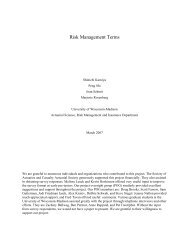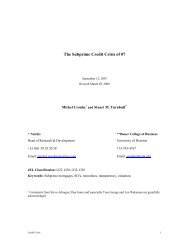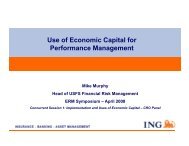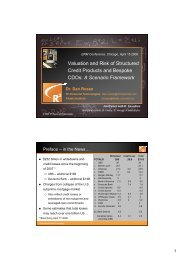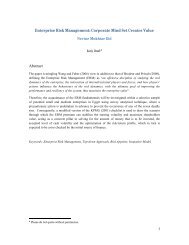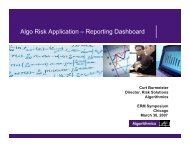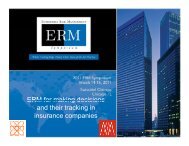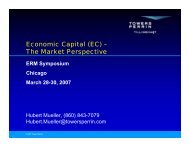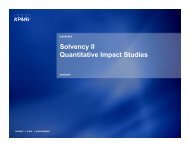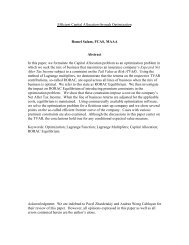Bayesian Risk Aggregation: Correlation ... - ERM Symposium
Bayesian Risk Aggregation: Correlation ... - ERM Symposium
Bayesian Risk Aggregation: Correlation ... - ERM Symposium
You also want an ePaper? Increase the reach of your titles
YUMPU automatically turns print PDFs into web optimized ePapers that Google loves.
the d-dimensional Gaussian copula is given by<br />
C d R(u1, . . . , ud) = Φ d R(Φ −1 (u1), . . . , Φ −1 (ud)) (2.1)<br />
where Φ −1 (·) denotes the inverse of the standard normal distribution function. The density<br />
of the d-dimensional Gaussian copula can be written as<br />
c d 1<br />
−<br />
R(u1, . . . , ud) = det(R) 2 exp<br />
with ξ = (Φ −1 (u1), . . . , Φ −1 (ud)) ′ and identity matrix Id.<br />
<br />
− 1<br />
2 ξ′ (R −1 − Id)ξ<br />
<br />
(2.2)<br />
We now turn to the estimation of the Gaussian copula which is usually done by<br />
maximising the corresponding likelihood function. Suppose x1, . . . , xn is an n-sample of<br />
d×1 mutually independent observations that are identically distributed. In the context of<br />
inter-risk aggregation each marginal component of xj, j = 1, . . . , n, represents a suitable<br />
risk driver or loss proxy representative for a different risk type. Specifically, assuming a<br />
Gaussian copula model means that all components of xj, j = 1, . . . , n, have a Gaussian<br />
dependence structure.<br />
After transforming the sample data xj into variates uj with uniform marginals (e.g.<br />
using order statistics or parametric distribution functions), we obtain for the likelihood<br />
of the Gaussian copula<br />
1<br />
−<br />
l(R|ξ1, . . . , ξn) ∝ det(R) 2 n exp<br />
<br />
− 1<br />
2 tr(R−1 <br />
B) . (2.3)<br />
Here, the d×d symmetric, positive semidefinite matrix B is the sample covariance matrix<br />
of the data after transformation to standard Normal marginals, i.e.<br />
B = 1<br />
n<br />
n<br />
j=1<br />
ξ jξ ′<br />
j with ξ j = (Φ −1 (u1j), . . . , Φ −1 (udj)) ′ , (2.4)<br />
which is also the global maximum of the likelihood function (2.3), see e.g. Press [20], p.<br />
183. Without loss of generality, we may always use a standardised sample ξ j that has<br />
exactly unit sample variance so that B equals the sample correlation matrix. Then we<br />
finally obtain the MLE of the Gaussian copula parameter as<br />
ˆR = 1<br />
n<br />
n<br />
j=1<br />
ξ jξ ′<br />
j .<br />
After the matrix ˆ R has been determined, one can start risk-type aggregation. As men-<br />
tioned in the introduction, we adopt the portfolio used in Böcker [5] consisting of 10 %<br />
market risk, 61 % credit risk, 14 % operational risk, and 15 % business risk, representing<br />
5



